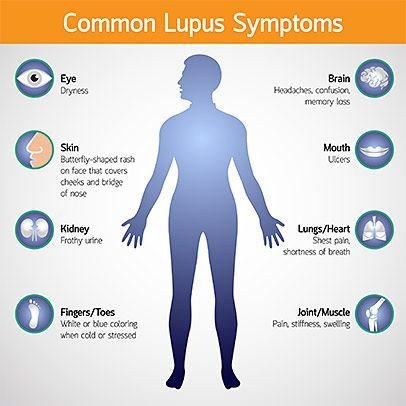Lupus is an autoimmune condition wherein the immune system harms the healthy tissue and cells in the body. Individuals with lupus display varied symptoms based on the particulars of each case. These symptoms may be mild in some cases while severe in others. Some common and painful lupus symptoms include swollen and painful joints along with fatigue and unexplained fever.
A red skin rash called malar or butterfly rash is often one of the commonly observed lupus symptoms and it can be seen to appear across a patient’s cheeks and the nose. The rash may also be seen on the upper arms, face and the ears, chest, hands and the shoulders as well. People suffering from lupus are quite sensitive to sunlight and skin rashes tend to get worse on exposure to sunlight. So people with lupus often have to wear sun screen agents and avoid exposure to ultraviolet light.
Some other lupus symptoms include chest pain particularly on deep breathing, loss of hair, unexplained fever, photosensitivity, swollen legs and eyes, mouth and nose ulcers, fatigue and swollen glands. The symptoms of this condition may appear for some time and then disappear. Other symptoms include paleness or purple color in toes and fingers because of stress and cold.

Some people suffering from lupus may experience certain lupus symptoms such as dizziness, headaches, confusion, seizures and depression. Many people experience new and different symptoms and these symptoms may appear after the initial diagnosis and in some cases different symptoms may be observed at different points of time. In some cases only one part or system of body may be affected and this may include the joints or the skin. In some other cases individuals may experience varied symptoms in different parts.
The extent to which a person may be affected with lupus symptoms varies from case to case. Some patients may experience severe symptoms such as kidney inflammation and this can be determined from a swelling in the ankles. Some people may develop inflammation in the chest cavity lining. This can cause chest pain particularly when the patient tries to breathe. In some patients the condition can even affect the central nervous system and this can cause dizziness, headaches, vision problems, stroke, seizures and other changes in the behavior.
Vasculitis or inflammation of blood vessels may also be observed in some cases and some people may experience inflammation of the heart. Women suffering from lupus and who are pregnant are at a great risk of suffering from premature birth or experiencing a miscarriage. Those patients who have a history of possible kidney disease are at a greater risk of preeclampsia.
Some other lupus symptoms may include dry eyes, depression, anxiety, memory loss and easy bruising. Skin rashes, fatigue, aching joints, slight fever and anemia are most commonly seen in lupus patients. Following the treatment plan is important to ensure that the problems associated with lupus are managed properly. A healthy diet plan and moderate exercise along with minimizing of stress can help in reducing the symptoms and problems of this condition.
What Is Lupus
Individuals researching or collecting information on what is lupus can find a plethora of websites giving detailed information about this condition. Lupus is basically a disease that afflicts the immune system. In this condition the immune system attacks the wrong objects thinking these to be foreign and harmful. In this condition excess proteins are created by a person’s immune system and these antibodies attach to the structures in a person’s body. This causes pain, inflammation and damage.
Information on what is lupus will also indicate that researchers, scientists and medical health professionals have not been exactly able to determine the causes for this condition. However it is believed that there are multitude factors that result in this condition. These may include genetic factors, environmental factors and hormonal problems as well. Some other aspects that may contribute include stress, certain kinds of medications, diet, some bacteria and viruses and exposure to light particularly ultra violet light.
Literature on what is lupus also indicates that this condition afflicts certain kinds of people. Around 90% of individuals suffering from lupus are women. Likewise people belonging to certain communities are more likely to suffer from this condition. So Latinos and African Americans are more likely to experience this condition as compared to Caucasians.
What is lupus can be better understood from the different types of lupus seen among people and the symptoms associated with these different types. Systemic lupus is the type wherein different systems or organs within the body may be involved and affected. In Discoid lupus a scaly and red rash may be seen on the areas that are exposed to the sun including the arms, face, scalp and legs and the trunk. Finally in drug induced lupus reactions to some medications may result in the development of this illness.
People suffering from lupus may experience the associated symptoms to varying degrees. In some patients the symptoms may be quite severe while in other individuals there may be flare ups. What is lupus can be understood better if the associated problems and symptoms are understood. People suffering from lupus experience weakness, fatigue and lethargy along with joint and muscle pain and swelling. Such a person may also experience fever and skin rashes.
Lupus also results in joint and muscle pain. People suffering from lupus also experience mouth and nose ulcers. In some cases the sac that surrounds the heart may experience inflammation and in some cases kidney problems may also occur. Diagnosis of lupus cannot be done easily and has to be conducted based on physical evaluation of the symptoms along with some laboratory tests.





